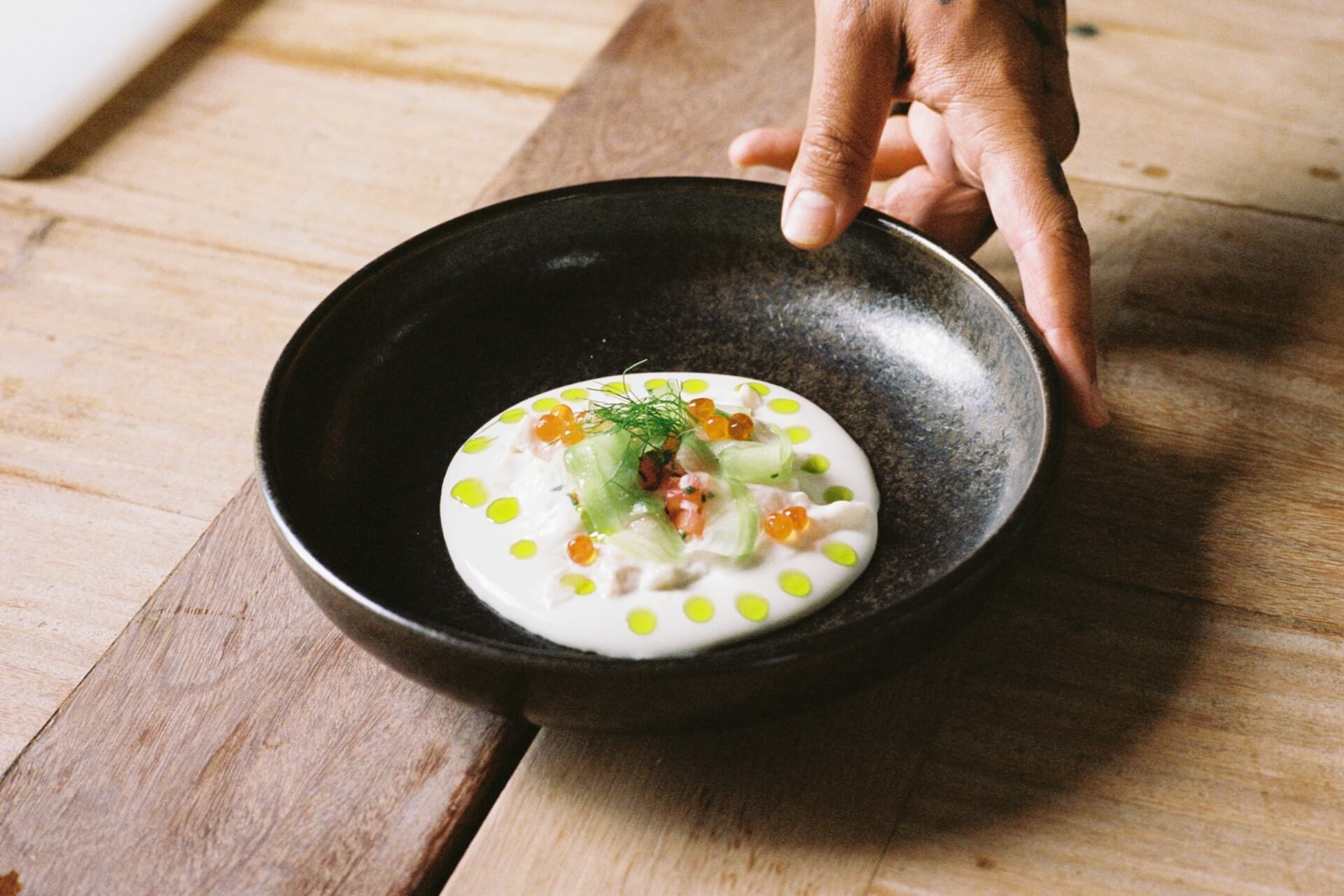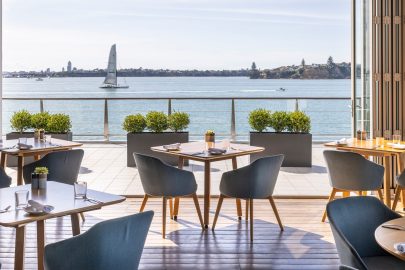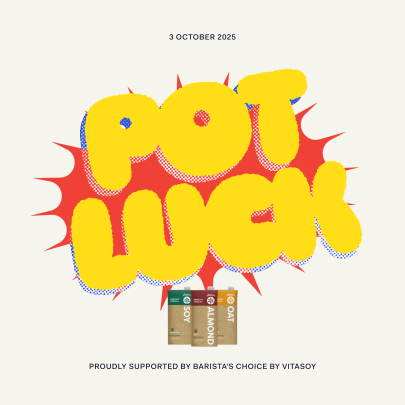Jun 24, 2024 Food
The best versions I’ve ever eaten sat at the centre of wharekai tables — the citrusy coconut sauce then oozing into the archipelago-like mounds of other dishes on my plate and being mopped up with torn hunks of fry bread. Or were scooped up with plastic sporks at markets, community festivals and school fairs, out of pottles flecked with a tri-coloured combination of vegetables. It’s everything I like in a single spoonful: chilled, creamy, astringent, salty, crunchy, fresh, sweet, fatty and sometimes even a little spicy.
Raw fish — or ika mata, ota ika, kokoda, coconut fish, oraora, poisson cru, oka i‘a, ika ota, ‘ota ‘ika, i‘a ota, depending where you are — is a voyager of a dish. It’s a staple in nearly every country in the South Pacific, and these days it’s also ubiquitous in Tāmaki Makaurau.
No matter where in the Pacific your raw fish dish is from, it can likely be broken down into four foundational elements: fish, citrus, coconut and vegetables. Its method is similar to that of South and Latin American ceviche or Filipino kinilaw: fish fillets are cut into bite-sized pieces, sometimes salted, and then briefly marinated in fresh citrus (the acid in the citrus denatures the protein networks of the fish, much the same as heating does). The marinated fish is then combined with coconut milk and some combination of raw vegetables.
While this general formula is shared across the islands of the Pacific, each place has its own idiosyncrasies depending on shared preferences and available ingredients. These include: the type of fish used, how the fish is cut, how long the fish is cured for, whether or not the fish is salted, what kind of citrus is used, what combinations of vegetables are added, and how thick the coconut milk is.
For example, in the Cook Islands, maroro (flying fish) is used, whereas ahi (tuna) is more common in Tahiti. In Fiji, the raw fish dish called kokoda includes chilli — reflecting the culinary influence of indentured labourers from India. Meanwhile, Tonga’s ‘ota ‘ika has a lot more vegetables than its Fijian counterpart. In Nauru, where the locals call it coconut fish, it’s often topped with a sprinkling of OXO stock powder.
Even New Zealand’s dairy-heavy diets have had an influence. One of my friends who is Tongan told me recently that her mum uses dairy cream rather than coconut cream/milk in her raw fish. If they were back in the Islands, she added, they’d definitely use fresh coconut. The raw fish recipe in my copy of the Maori Cookbook, produced by Glenfield College in 1977, is titled “Simple Tarakihi Cru” and involves a thoroughly mid-century mix of celery, sweetened condensed milk, yoghurt and cow’s milk.
Little seems to have been written on the exact origins of these raw fish dishes, though. The people who settled the Pacific brought the coconut palm with them from maritime Southeast Asia, and coconut became a staple ingredient throughout the region. Three species of citrus also made it at least part way into Polynesia as ‘canoe plants’, then many more lemon, lime and orange cultivars arrived with Europeans in the 1800s. Tracy Berno, a professor of food studies at AUT, tells me that while we don’t know precisely where or when the Pacific version of raw fish was brought into existence, “you can use your imagination and extrapolate out”. Both saltwater curing and dry salting of fish is common in traditional food preparation throughout the Pacific, including Aotearoa. “If you’re curing fish in seawater, and you want to add a bit more flavour to it, you might try squeezing something on it like citrus, and then through trial and error, see how the citrus actually changes the texture and the flavour of the fish.”
Later on, recipes for raw fish would have accompanied the thousands of Pacific people who migrated to Aotearoa from the 1960s onwards to fill labour shortages — a kind of edible link to home. From there, raw fish — the only dish in the Māori food canon that includes coconut — was adopted into the culinary repertoire of kai Māori, to such an extent that it now feels as if it’s a dish we had all along. When our ancestors made the voyage to Aotearoa they had to abandon coconuts (we tried to grow coconuts here, but it’s far too cold). I often think how devastating that loss must have been. So I have a particular fondness for raw fish because of that reclamation of coconut — like some kind of gift or rekindling of a long-lost friendship.
Rather than tracing to an exact place or time, the origins of raw fish reside in an ongoing story of voyaging, trade, colonisation, diaspora, ancestral ties, urbanisation, connections with the sea and the land, cultural exchange, innovation and adaptation. “The sea doesn’t keep us apart, it actually pulls us together,” says Berno. “Because [raw fish] is a product of the sea and it’s shared across all Pacific nations, it is one of those uniting things.” The dish is, by its very nature, dynamic, adaptable and ever-changing — a foundation on which tradition can continue and, at times, be reshaped.
A key benefit of Auckland being the ‘Polynesian capital of the world’ is the abundance of raw fish you can find around our city. If you’re looking for the classic, pottled style of raw fish, and don’t want to wait around for a festival or market or fair, Marsic Bros, Best Baits and Mangere Bulk Seafoods are all excellent options. I favour the version at the Ōtāhuhu branch of Toby’s Seafood where they use trevally and tomato and cucumber in a rich coconut. It’s one of the most reliably well-balanced versions you’ll find — with a good salt-to-fat-to-acid ratio — and I like that you can order a fry bread or two to eat with it. If you’re looking for a dairy version, you’ll find it just down the road from Toby’s at Tongan eatery Hala Hihifo, where they make their ‘ota ‘ika with fresh cream, tomatoes, spring onions, cucumber and fresh chilli.
In central Auckland, it’s harder to find raw fish in ready-to-go pottles (other than at Blue Rose in Sandringham, my dependable go-to). What you will find, though, are abundant raw fish iterations on restaurant menus. These often incorporate, as the dish always has, new cultural culinary influences — in some cases challenging the very definition of the dish. They can also be significantly pricier, too (you might be paying two, three, even four times as much as their counterparts in the south or west of the city).
I’ve had the raw fish at the old Homeland (now looking for a new home), where it took a contemporary form: coconut yoghurt, coriander and curry leaf oil and chilli ginger jelly, with crispy sago wafers perched on top. On a recent Saturday lunch at Sāmoan fine-dining restaurant Tala I was served their oka as part of a seven-course dégustation. The teensy frilled plate was piled with cured salmon, avocado and (like Homeland) coconut yoghurt, with the ubiquitous tomato element transformed into a powder. Neo-bistro Céleste has a version on their menu that adds melon and streaks of verdant herby oil. There is a kingfish dish at recently opened Anise , too, which is not raw fish per se (in fact it’s far closer to a crudo), but as it involves a lot of the components that I’d associate with kokoda — raw slices of fish, a kind of whipped coconut sauce, cucumber and chilli jam — I assume there was at least some Pacific inspiration at play.
One of the most intriguing versions I’ve had recently was at contemporary Chinese restaurant Xiexie. Their “mala ika mata” had a modernist presentation: a rectangular block of tuna with piped avocado and salted duck yolk in a pool of coconut milk flecked with the recognisable numbing spice of málà. For traditionalists, this dish might stray too far from convention, and I’d certainly prefer it without the dill and avocado — but I found myself reflecting on the remarkable chain of influences as I ate. A modern Sichuan take on a dish brought here from the islands of the Pacific — where else in the world but Tāmaki would this exist?
When I think about this city’s Pacific identity, the first thing that comes to mind is Grey Lynn. After the past three decades of gentrification, this may seem like an outdated vision. But it’s where I grew up and formed my own set of values around what it means to be Māori in this big, Polynesian city. Because I still live in Grey Lynn, I know a vivid Pacific identity remains here — even if these days it’s quieter and more difficult to find between the rows upon rows of starkly white villas.
So I thought about Ada , with its Māori-inspired menu, in the old convent building in Grey Lynn village. At Ada, ika mata has been refined to near-obsessive levels by chef Kia Kanuta, somehow without taking away from the soul of the dish — a feat. It’s a dish Kanuta brought to the menu when he took over a year ago, inspired by the various kinds he grew up with. (When Kanuta makes raw fish on his home whenua, he’ll salt the fish with seawater, a method passed down to him intergenerationally.) “Having ika mata on my menu was important to me, because it’s reflective of the communities that I grew up in,” Kanuta tells me. “My two next-door neighbours were Sāmoan, my bro across the road was Tongan, and it was something we all ate.”
To make the dish at Ada, they use tarakihi fillets — or more specifically, the skinless, boneless belly sides of the fillet, which are fattier. (The other, thicker sides of the fillet are smoked for Ada’s smoked fish and rēwena dish.) Adopting techniques found in other Island kai, the coconut component involves cooked and blended onions, giving the sauce a viscosity and mellow sweetness. The finished bowl will look remarkably familiar to anyone who’s grown up with raw fish, aside from a few marks of artistic flair.
This balance of refinement with convention ultimately comes out of a sense of respect for Kanuta’s Māori and Pacific clientele, who grew up with the dish as he did. “You can’t step too far away from tradition, especially when you’re serving Māori and Pacific brothers and sisters,” says Kanuta. “How do you give them something they’ve been eating their whole lives and still make them feel like they’ve had something new?”
Ika mata offers a vessel for Kanuta to honour his own definition of kai Māori. “It’s not really about what’s on the plate,” says Kanuta. “What ends up on the plate is the end result of ethical fishing, of humane gathering and hunting, of making sure that my chefs don’t have to worry about bereavement leave only being for three days if they need to go to a tangi.”
Eating raw fish is not without its contradictions. While raw fish is a celebration of the ocean and its bounty that have sustained the indigenous people of the Pacific for thousands of years, as we all know, the moana and kaimoana both here and throughout the Pacific are unwell. The presence of raw fish might seem like proof that we really are the ‘largest Polynesian city in the world’, but the systemic marginalisation of Māori and Pacific communities says otherwise. Helen Leach once wrote that “culinary traditions are so deeply associated with people’s sense of identity that they are powerful agents of resistance”. Raw fish, then, might be seen as a model for how we can move as one, all the while maintaining what makes us, and our bowls of coconutty, citrusy fish, unique.
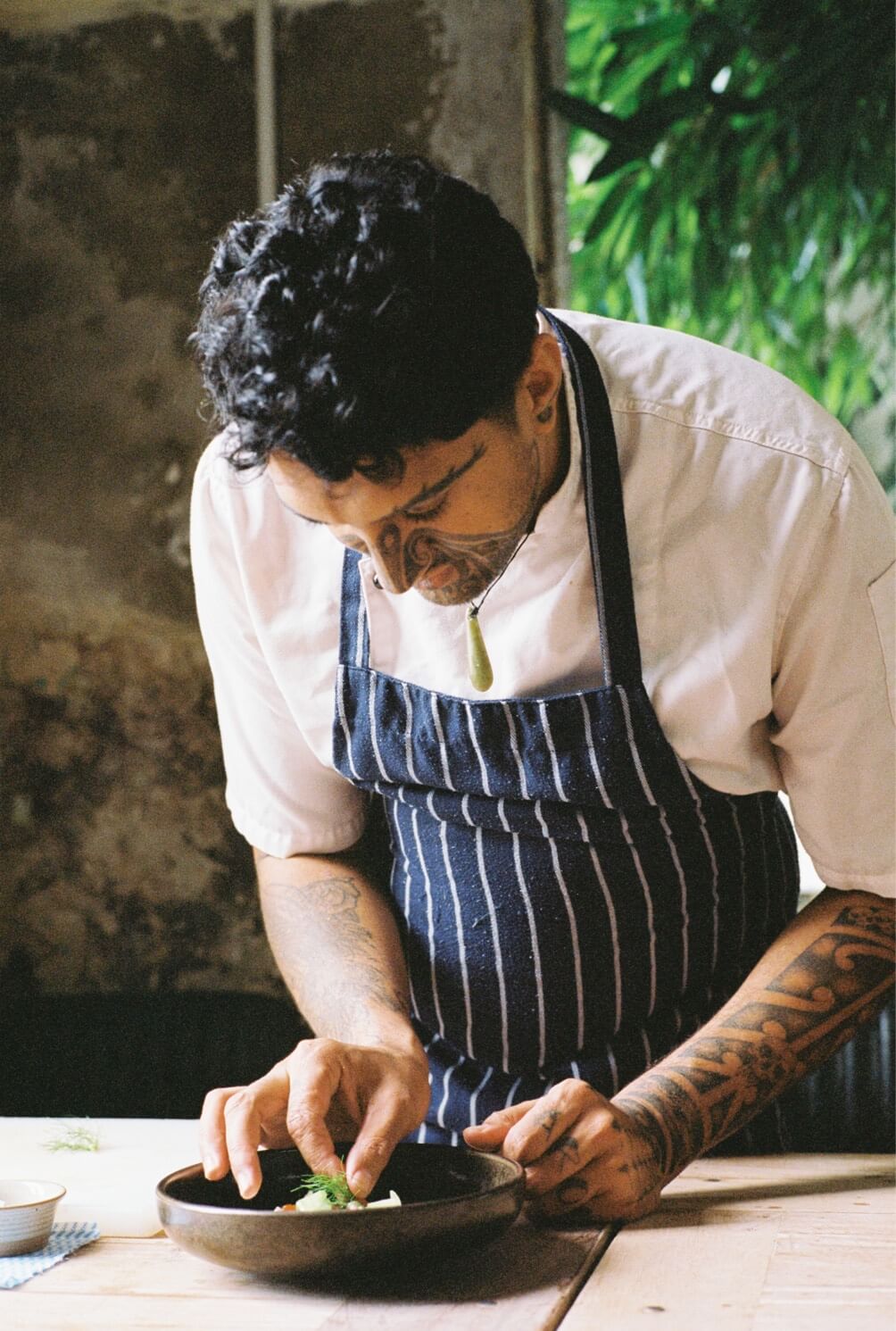
Ika Mata
By Kia Kanuta at Ada
Home-sized portion
Serves four as a main dish with a side of toast or, ideally, fry bread.
INGREDIENTS
Wairanu / sauce
1 brown onion
2 tbsp olive oil
400ml can Kara coconut cream
400ml can Kara coconut milk
Ika / fish
400g tarakihi fillets (skinned and boned)
1 bowl cold water with 1 tbsp salt dissolved
3 lemons
1 tbsp flaky salt
600ml very cold water
Kīnaki / garnish
2 red tomatoes
1 red onion
1 telegraph cucumber
1 jar of caviar (we like salmon)
METHOD
For the wairanu / sauce
Finely dice your onion, then gently sweat in a medium pot with olive oil. When the diced onion has become transparent, add both the coconut cream and coconut milk.
Bring this mix to a gentle simmer, stirring continuously so the sauce doesn’t catch. After 8 to 10 minutes, remove from heat and leave to cool.
Once cooled, blend on high using a blender for about 20 seconds, then pour through a sieve and set aside.
For the ika / fish
Rinse the fillets in your prepared bowl of cold salted water for five minutes. Pat dry and slice into thin thumb-length strips (think sashimi) with your sharpest knife.
Place the sliced fish into a large bowl. Juice the three lemons directly on to the fish and mix well. Add the flaky salt and mix well again. Finally, add the cold water, mix again and let sit in the fridge for one hour.
Then strain and set aside.
For the kīnaki / garnish
Cut the tomatoes into quarters and remove the seeds. Slice the flesh long ways and then across into smaller pieces before adding to a bowl. Finely dice the red onion and add to the chopped tomato.
Remove the skin from the cucumber, then shave it into ribbons using a peeler. Set aside.
To serve
Combine the fish with the prepared coconut sauce.
Spoon into serving bowls and pile with the chopped tomatoes and onions. Then top with the cucumber ribbons.
Garnish each bowl with caviar for extra colour and texture.
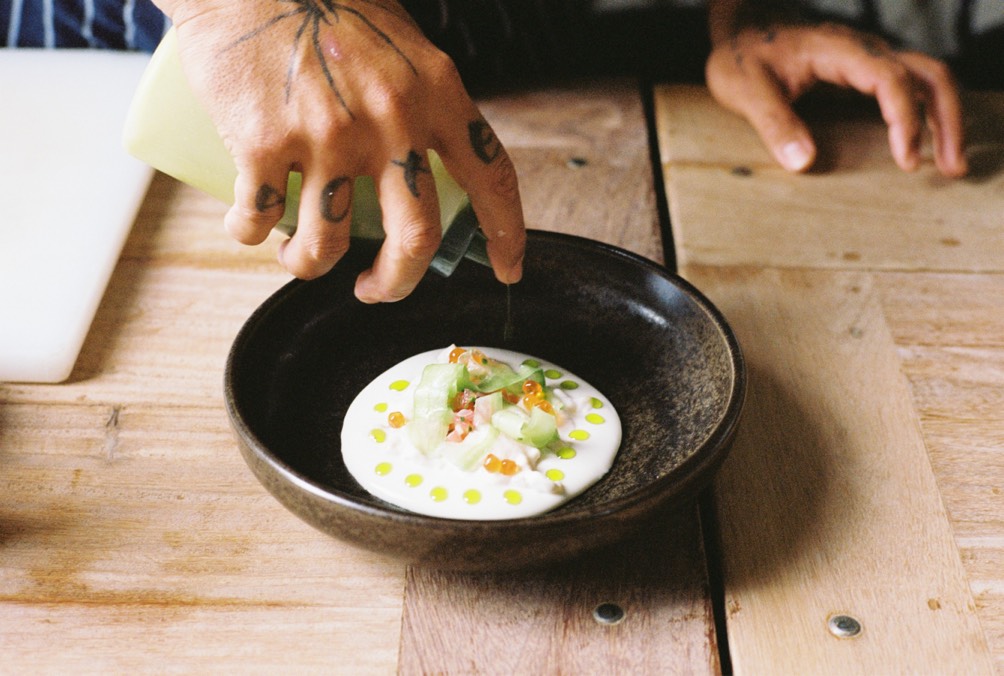
Marae-sized portion
Sufficient to cater for 250 as a shared hākari component.
INGREDIENTS
Wairanu / sauce
15 brown onions
1.5 cups olive oil
6 1L carton Kara coconut cream
6 1L carton Kara coconut milk
Ika / fish
6.25kg tarakihi fillets (skinned and boned)
1 large bowl cold water with 2 cups salt dissolved
45 lemons
1 cup flaky salt
9L very cold water
Kīnaki / garnish
30 red tomatoes
15 red onion
15 telegraph cucumber
7 jars of caviar (we like salmon)
METHOD
For the wairanu / sauce
Finely dice your onions, then gently sweat them in a large pot with the olive oil. When they have become transparent, add the coconut cream and coconut milk.
Bring this mix to a gentle simmer, stirring continuously so the sauce doesn’t catch. After 8 to 10 minutes, remove from heat and leave to cool.
Once cooled, blend on high using a blender for about 20 seconds, then pour through a sieve and set aside.
For the ika / fish
Rinse the fillets in your large bowl of cold salted water. Pat dry and slice into thin thumb-length strips (think sashimi) with your sharpest knife.
Place the sliced fish into a large bowl. Juice the lemons directly on to the fish and mix well. Add the flaky salt and mix well again. Finally, add the very cold water, mix again and let sit in the fridge for one hour.
Strain and set aside.
For the kīnaki / garnish
Cut the tomatoes into quarters and remove the seeds. Slice the flesh long ways and then across into smaller pieces before adding to a bowl. Finely dice the red onion and add to the chopped tomato.
Remove the skins from the cucumbers, then shave them into ribbons using a peeler. Set aside
To serve
Combine the fish with the prepared coconut sauce.
Spoon into serving bowls and pile with the chopped tomatoes and onions. Then top with the cucumber ribbons.
Garnish each bowl with caviar for extra colour and texture.

